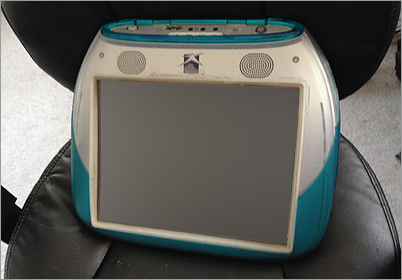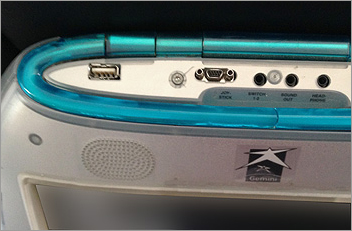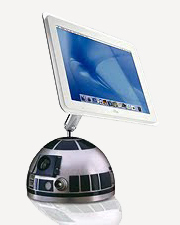The Gemini iBook – a Mac OS 9 Touchscreen Tablet Mac

A new addition arrived at the Vintage Mac Museum this week, and it’s a part of the Apple universe I never even knew existed before. Behold the Gemini iBook – a clamshell iBook G3 modified to be a touchscreen based Macintosh tablet!
Touchscreen computers using a tablet form factor have been around for a long time. Besides those ubiquitous UPS and FedEx signature devices, and PDAs like the Palm and the Newton, touchscreens have long worked well for assistive technology devices used by the disabled. Laptop monitors have been fitted with touchsceens for this purpose, but better still is a laptop that is converted into a one-piece tablet. A decade before the iPad, a clamshell iBook G3 was married with a touchscreen to create this fully functional tablet Macintosh. The Axiotron ModBook didn’t appear on the stage until 2007.
The (now defunct) company Assistive Technology produced these systems back in 2001. The screen and keyboard of the iBook were replaced with an embedded touch sensitive display panel. A small peripheral interface board along the top edge of the computer sports a USB port (moved from the side panel), a mini-joystick port, a mini TRS input switch port, sound out and sound in headphone ports. The iBook retains the ethernet port, modem, and CD-ROM drive. A popup keyboard (a la iOS) is available to type directly on screen, or you can use an external USB mouse or keyboard. Speech recognition and synthesis software was originally installed, but this had been removed before I obtained the system.

I stumbled across this puppy during a recent visit to Unicom, a well-stocked vintage Mac service and sales shop in Rhode Island. I’ve generally disliked the clamshell form factor and those garish colors – graphite excepted – but this modified unit in bondi blue actually looks pretty cool. This is a useful form factor to work with, quite small and compact (for the era). With more expansion ports than any iOS device and the full Mac OS running the show, it’s actually a very capable computer.
My unit definitely shows some wear and tear – the handle has a few cracks, the display has some scratches, and the Gemini decal on the front is starting to bubble. But it still runs well on the original 3GB (!) hard drive and 160MB of RAM. I updated the installed Mac OS 9.0.4 to version 9.2.2, then loaded up Microsoft Office 98 and the latest version of the Classilla web browser. With more RAM the system could be configured to run Mac OS X, but I’m happy running the classic OS. The iBook Clamshell website has a video of the system running OS X along with pictures of the interior.
This may be one of the only Mac OS 9 based tablets in the world!
What a cool little system. Originally costing nearly $7500, it was a bargain in the clearance bin at $100. Now I just need something a little lighter – hmmm, how can I add a USB port to my iPad?


Hi, Mr. Rosen,
I have a Gemini iBook exactly like yours with Speaking Dynamically Pro v2.6 and Gemini Touchscreen (TSHARC-USB Calibration Rev 1.05). I am trying to fix it so that a stroke patient can use it to express her ADL needs. The problem is right now I can’t go through the calibration process successfully, as a result the patient can’t touch a picture on the screen and have the computer say that item (e.g. apple) for her. Right now after I open Gemini Touchscreen and click calibrate, the computer asks me to touch the red dot but no matter how hard I press the red dot it does not register. I used the mouse and a CD to confirm that Speaking Dynamically Pro v2.6 works fine.
Could you give me some suggestions to try to get the touchscreen work?
Many thanks in advance.
Jim
Jim, my system includes two Control Panels named Gemini Display as well as Gemini Touchscreen, do you have these installed? If yes, it’s possible the touchscreen has a hardware problem.
Hi, Adam,
Thanks for the fast reply. Yes, I see both under Control Panels. It was working fine with my previous patient. After the patient passed away, it sat in my closet for several years. Now when I try to let another patient use it, I have problem calibrating the screen. Sometimes after startup the desktop font would be much smaller. In this case the red dot would be on the 4 edges of the screen indicated by triangle and I was able to touch the red dot to the next position. After calibration though the screen still does not work right. Most times after startup the desktop font has the right size in which case touching the red dot in the cross center would not move to the next position at all. If it is a hardware problem, is there anything I can do to test and hopefully fix it? Thanks. Jim
I’m not sure what you can do, short of finding another one. These devices were quite groundbreaking in their day, but have since been superceded and the original vendor no longer in business. In particular, the iPad has seen steady improvement and adoption for offering assistive technologies for the disabled, both via iOS and third party apps. I’d probably focus my efforts there. apple.com/support/accessibility/
Hi there! I thought I’d post a message since I am one of the original (re)designers of that device. The device was designed by MOTO Development Group in San Francisco (where I was an Engineer). It was built by a contract manufacturer in New Hampshire.
The display is the original display flipped around to face outward and with a USB touch panel installed over the top. Original parts were machined to fit the new connectors and add grilles for the new outward facing speakers.
I have forgotten more nitty gritty details since it was almost 15 years ago, but that’s cool to see they’re still alive and out there being used!
Matt
Hi Matt, thanks for checking in! Do you have any copies of the software which originally shipped with the Gemini? As noted in the article the speech recognition and synthesis software is missing. Also was this project officially “blessed” by Apple, or was it a completely aftermarket endeavor?
I do not have the software.
The project did not involve Apple at all that I know of. We simply disassembled and reassembled the units in the new configuration.
I wish i could get one of those units I would love one for collection if anyone has one my email is stpworld2006@hotmail.com